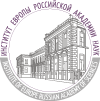Articles submitted to the journal "Scientific and Analytical Herald of the Institute of Europe of the Russian Academy of Sciences" should be formatted in accordance with the rules adopted in the journal, which correspond to the rules of international databases for citing periodicals (Scopus, Web of Science, ERIH Plus).
- the total volume of the manuscript should not exceed 40 thousand characters (with a scientific apparatus), including spaces, and must be at least 18 thousand characters (without a scientific apparatus);
- articles should be sent to e-mail: This email address is being protected from spambots. You need JavaScript enabled to view it.;
- tables, charts, graphs, drawings and other illustrations should be given on a separate page, numbered and titled;
- the text of the article should be provided with a joint list of references "References", which contains all the scientific and analytical literature used in the work. Links are made according to the system developed by the editors of the journal (see the section "References");
- the article should indicate the article code according to UDC (the author independently determines the code of the article, see: http://teacode.com/online/udc/ or http://www.udcc.org/udcsummary/php/index.php)
- the author is obliged to indicate the sources of all quotes, figures, other information, to explain uncommon abbreviations.
- the authors are responsible for the selection and accuracy of the given facts, quotations, economic and statistical data, proper names, geographical names, and other information, as well as for the use of data not intended for open publication.
- the article requires an abstract (no more than 200 words) in Russian and English and keywords: 5-10 words also in Russian and English.
- The materials published in the journal may not reflect the point of view of the founder, editorial board, and editorial board.
- by submitting the manuscript of his article to the editorial, the author undertakes not to publish it either in full or in part in another publication without the consent of the editorial board.
The author provides the following information about himself in Russian and English:
- full name,
- the official name of the place of work (in Russian - in the nominative case), address of the place of work (country, city)
- position
- academic degree
- as well as data for contacting the author: email address
The listed information must be submitted with each new incoming article, regardless of whether the author is published for the first time or re-published.
There is no fee for publishing manuscripts.
Abstract
The abstract is a source of information independent of the article. It is written after completion of work on the main text of the article. It includes a description of the main topic, problem, object, purpose of the work and its results. It indicates what is new in this document in comparison with others related in subject matter and purpose. The recommended volume is 150-200 words in Russian and English.
The abstract performs the following functions:
- allows you to determine the main content of the article, its relevance and decide whether to refer to the full text of the publication;
- provides information about the article and eliminates the need to read its full text if the article is of secondary interest to the reader;
- used in information, including automated, systems for searching for documents and information.
Annotations should be formatted according to international standards and include the following points.
1. Introductory remarks about the research topic.
2. The purpose of scientific research.
3. Description of the scientific and practical significance of the work.
4. Description of research methodology.
5. Main results, conclusions of the research work.
6. The value of the research (what contribution this work has made to the relevant field of knowledge).
7. The practical significance of the results of the work.
The abstract should not repeat the text of the article itself (you cannot take sentences from the article and transfer them to the abstract), as well as its title. It should not contain figures, tables, inline footnotes.
The abstract should state the essential facts of the work, and should not contain material that is not in the article itself.
The subject, theme, purpose of the work are indicated if they are not clear from the title of the article; it makes sense to describe the method or methodology of the work if they are new or are of interest from the point of view of this work.
The results of the work are described extremely accurately and informatively. The main theoretical and experimental results, factual data, discovered relationships and regularities are presented. At the same time, preference is given to new results, important discoveries, conclusions that refute existing theories, as well as data of practical importance.
Conclusions may be accompanied by recommendations, assessments, suggestions, hypotheses described in the article.
The information contained in the title of the article should not be repeated in the text of the author's summary. The text of the abstract should use syntactic constructions typical of the language of scientific and technical documents, and avoid complex grammatical constructions. It should be concise and clear, without unnecessary introductory words, general formulations.
Key words
Key words express the main semantic content of the article, serve as a guide for the reader and are used to search for articles in electronic databases. Placed after the abstract in the amount of 5-10 words, given in Russian and English. Should reflect the discipline (field of science within which the article is written), topic, purpose, object of study.
















